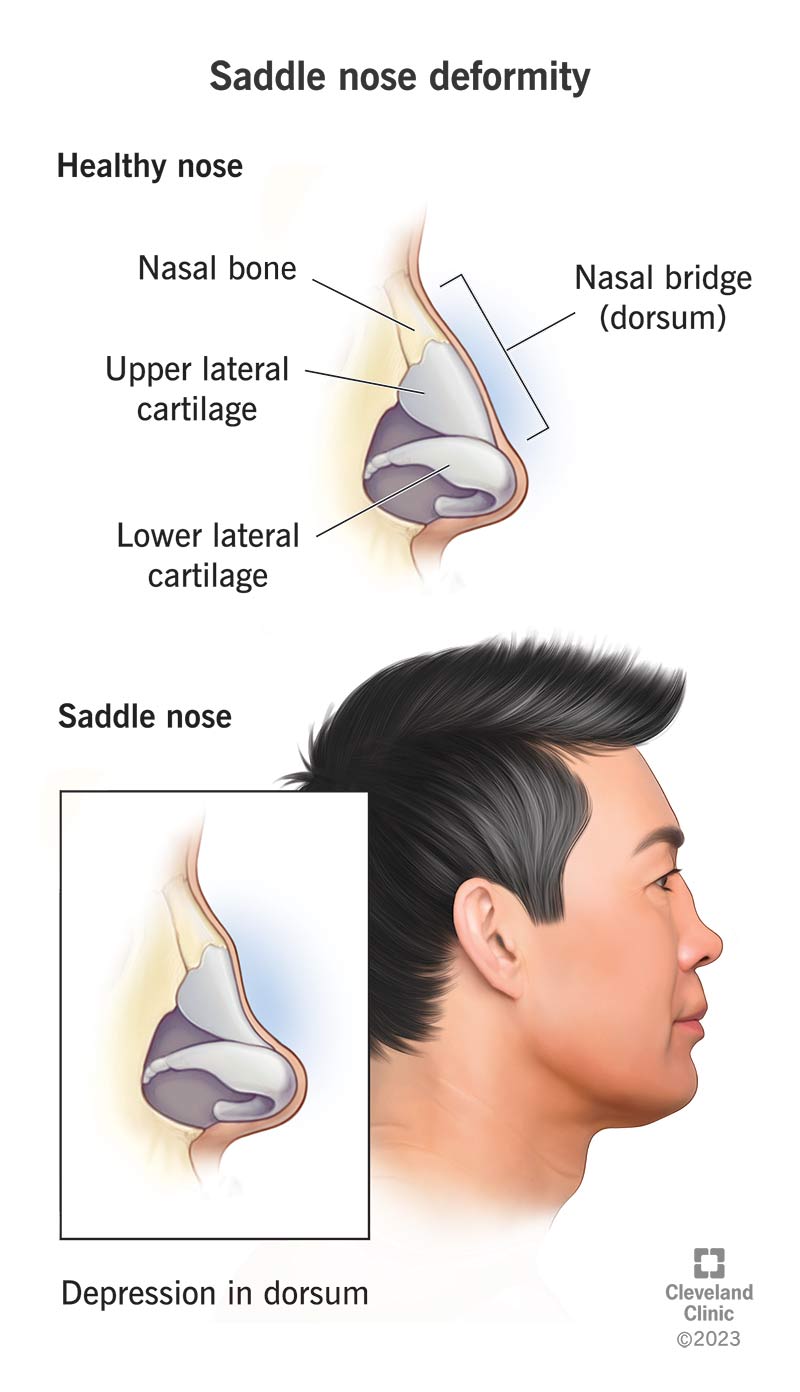Saddle nose deformity refers to a collapsed nasal bridge, which causes the middle portion of your nose to sag. Trauma, infections, surgeries and substance use disorder can all cause the condition. The main treatment for saddle nose deformity is rhinoplasty, commonly known as a nose job.
Advertisement
Cleveland Clinic is a non-profit academic medical center. Advertising on our site helps support our mission. We do not endorse non-Cleveland Clinic products or services. Policy

Saddle nose — or saddle nose deformity — refers to the collapse of your nasal bridge (the middle part of your nose) and loss of nasal height. The condition gets its name from the sunken-in, saddle-like appearance.
Advertisement
Cleveland Clinic is a non-profit academic medical center. Advertising on our site helps support our mission. We do not endorse non-Cleveland Clinic products or services. Policy
Saddle nose deformity changes the appearance of your nose. But it can also cause breathing issues that may interfere with everyday life. Left untreated, saddle nose can worsen over time.
Other names for saddle nose deformity include boxer’s nose and pug nose.
The telltale sign of saddle nose is a dip in your nose bridge. This concavity may become more obvious over time.
Some people may develop saddle nose almost immediately, which often happens in cases of trauma. Others may develop signs gradually.
Other saddle nose symptoms may include:
Anything that damages your nasal septum can lead to saddle nose deformity. This is because your septum provides structural support for your nose. Some people may be born with saddle nose.
Specific saddle nose causes include:
Advertisement
Saddle nose can cause a number of breathing complications, including:
A healthcare provider can diagnose saddle nose during a physical examination. They’ll ask about your symptoms in detail and discuss your cosmetic goals. They’ll also ask about any breathing issues you’re having. They may take photographs of your nose to document the severity of your condition.
Healthcare providers categorize saddle nose deformities into three stages, according to how much structural support you’ve lost:
Surgery is the most common treatment for saddle nose deformity. However, some mild cases may respond to dermal filler injections.
Rhinoplasty — also known as a nose job — is plastic surgery to change your nose’s shape and size. Surgeons use a combination of bone, cartilage and tissue grafts to rebuild your nose and restore your breathing.
In mild cases, when appearance is the main concern, dermal fillers can correct saddle nose. Some people call this nonsurgical rhinoplasty. Results are temporary, though — and you’ll need treatments every six months to maintain them.
Dermal fillers can’t improve breathing issues that arise from saddle nose deformity. You’ll need rhinoplasty for that.
In general, most people feel better in four to six weeks after rhinoplasty. However, your nose will continue to heal over the course of a year. The recovery timeline varies for everyone.
People who receive dermal fillers typically don’t require any downtime.
Most people with saddle nose deformity can correct the issue with rhinoplasty. However, success of treatment depends on several factors, including the severity of your condition. Talk with your healthcare provider to find out what to expect in your situation.
Saddle nose deformity can also occur after rhinoplasty for other conditions. This may happen if surgeons remove too much cartilage during the procedure. In these cases, a second rhinoplasty may be necessary. To avoid complications like this, choose a board-certified facial plastic surgeon or otolaryngologist (ENT).
You can’t always prevent saddle nose deformity. In some cases, it’s a symptom of unavoidable trauma. It may also be congenital in some cases (meaning you’re born with it).
Advertisement
To reduce your risk of saddle nose deformity:
You should schedule a visit with a healthcare provider at the first sign of saddle nose. The sooner you undergo treatment, the more predictable your results.
If you have saddle nose deformity, here are some questions to ask your healthcare provider:
Saddle nose deformity may be a symptom of more serious autoimmune disorders, including relapsing polychondritis and granulomatosis with polyangiitis (formerly called Wegener’s). For this reason, you should see a healthcare provider if you suspect saddle nose.
Saddle nose deformity refers to a sunken-in nasal bridge and a loss of nasal height. It happens when the cartilage that gives your nose shape breaks down. Rhinoplasty is the most common treatment for saddle nose, and most people achieve desired results with this approach. When correcting saddle nose, prompt treatment is key. If you notice sagging in your nasal bridge that wasn’t there before, schedule an appointment with a healthcare provider.
Advertisement
There are many reasons you might be thinking about getting rhinoplasty. No matter what the reason, Cleveland Clinic’s experts are here to help.

Last reviewed on 05/10/2023.
Learn more about the Health Library and our editorial process.